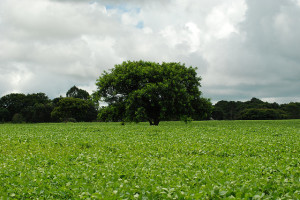Brazil’s Logistics Tested by Soybean Output

Soybean field in Morrinhos, Goias, Brazil
Photo credit: Flickr user AC Moraes
Creative Commons license
Profits from Brazil’s expected record soybean production could be hurt by declining currency and persistently unpredictable and expensive transportation, according to a new Rabobank report.
The additional expenses associated with bringing products to market could undermine farm incomes and discretionary crop protection applications. However, this could set the stage for an uptick in post-harvest pesticides, according to the the 2014 Brazil Agribusiness Outlook report by Rabobank’s Food & Agribusiness research team. Rabobank said that greater crop volumes combined with rising fuel prices indicate that a decline in transportation costs is unlikely for 2014.
Brazil is set to produce 91 million tonnes of soybeans for 2013/2014, 9% more than total yields in 2012/2013.
The report’s estimates are slightly greater than projections by Brazil’s national food supply agency Conab that yields would equal 90.3 tonnes, while Brazil’s Minister of Agriculture Antonio Andrade predicted in January that production could reach 95 million tonnes.
While soybean exports are expected to increase, rising fuel prices are likely to offset profit margins, according to the report. Production regions are geographically dispersed far from key ports, contributing to the cost of logistics and shipping. Diesel prices were raised three times in 2013, most recently by 8% in November. Infrastructure development and engineering in the transportation sector will likely also be a significant factor affecting growth, Rabobank says.
Negative economic growth is expected for Brazil in 2014, a domestic factor that could affect margins. Internationally, the price of Brazil’s exports has dropped. As a result of higher interest rates, greater debt, and inflation, exports alone are unlikely to sustain the country’s competitiveness in the global marketplace, according to Rabobank.
“Due to slowing economic growth and high inflation in Brazil, the domestic market will have limited scope to drive growth in sales in 2014,” Rabobank analyst Andy Duff said in a press release. “It is possible that some growth may come from exports, but with declining global commodity prices, revenue growth would have to come from an increase in export volumes, or a declining exchange rate, or both.”
However, crop exports could benefit from a decline in the Brazil/U.S. dollar exchange rate because Brazil is well-placed to fulfill increased demand for imports in comparison with competing suppliers, according to the report.
“Although Brazil is slowly addressing its bottlenecks, this will take years,” said Duff. “For 2014, with higher fuel costs and another large grain harvest, logistics costs for Brazilian agribusiness are unlikely to decline.”
Soy farms have increased in area the most of all of Brazil’s commodity crops. Additional areas of expected growth include the comprehensive grain harvest and beef exports. Depending on weather conditions, sugarcane production could also increase.






